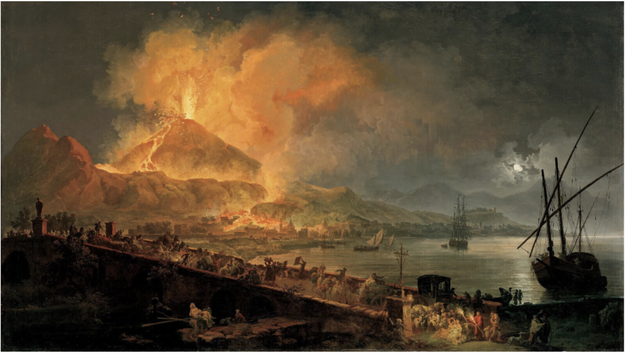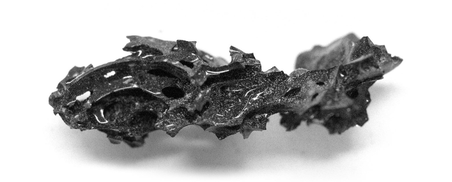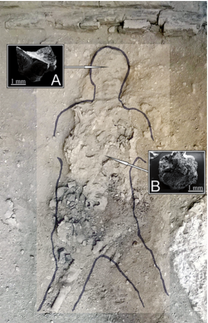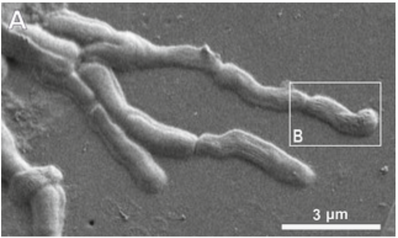|
Written by: Shreya Rajachandran ‘22 Edited by: Naphat Permpredanun ‘24 He was found face-down on a wooden bed, under a pile of volcanic ash during the excavations of the Collegium Augustalium in Herculaneum in the 1960s. The young man - around 20 years old - was a member of the elite class, possibly the guardian of the building he was found in. Like many bodies found in Herculaneum and Pompeii from the 79 CE explosion of Mount Vesuvius, the remains of the young man were incredibly well-preserved, allowing researchers insight into his lifestyle and status [1]. Normally, the remains found at this site are mainly skeletal because the heat of the eruption vaporizes any tissue [2]. However, by using a scanning electron microscope, scientist Pierpaolo Petrone and his team discovered a vitrified neural system and brain in the remains of the young man they found in the Collegium, documented in their study “Preservation of neurons in an AD 79 vitrified human brain."
Using non-invasive techniques such as electron microscopy and energy-dispersive X-ray spectroscopy (EDS), the research team observed structures in the vitrified spinal cord and brain tissue that resembled networks of axons and neuronal cell bodies. High sensitivity of the electron microscope allowed the team to see remarkable images of the neural network in the preserved tissue, while the X-ray spectroscopy showed that the substance consisted of organic matter, confirming its identity as vitrified tissue [1]. One example of these findings is the image of the myelinated axons imaged in the brain tissue, pictured below. To confirm the presence of the neuronal networks in the vitrified tissue, the study analyzed the expression of several neural genes with the expression of proteins identified in the neural tissue. Notably, the genes were differentially expressed based on the location of the sample, confirming the imaging findings of the scanning electron microscope, which found different structural neural networks based on the location of the imaged tissue [1]. Petrone et al.’s study is incredible in that it allows us insight into the health and literal brain matter of ancient peoples. This discovery has profound implications on the practice of bioarchaeological investigation by highlighting new forms of evidence that were previously undetected [1]. Ultimately, it could also provide insight into the historical evolution of the human brain and help answer the question that has driven historical research for centuries: How different are we from our ancestors? Works Cited :
[1] Petrone P, Giordano G, Vezzoli E, Pensa A, Castaldo G, Graziano V, et al. Preservation of neurons in an AD 79 vitrified human brain. PLOS ONE. 2020 Oct 6;15(10):e0240017. [2] Barras, C. Jan. 23, 2020. Studies reveal gruesome last moments of Pompeii volcano’s victims [Internet]. Science | AAAS. 2020 [cited 2021 Feb 28]. Available from: https://www.sciencemag.org/news/2020/01/studies-reveal-gruesome-last-moments-pompeii-volcano-s-victims [3] Mount Vesuvius eruption: Extreme heat “turned man’s brain to glass” - BBC News [Internet]. [cited 2021 Feb 28]. Available from: https://www.bbc.com/news/world-europe-51221334 [Image Citation] Painting of the Week: Pierre-Jacques Volaire, Eruption of Mount Vesuvius [Internet]. [cited 2021 Feb 28]. Available from: https://www.dailyartmagazine.com/painting-of-the-week-pierre-jacques-volaire-eruption-of-mount-vesuvius/ [Image Citation] Petrone P, Giordano G, Vezzoli E, Pensa A, Castaldo G, Graziano V, et al. Preservation of neurons in an AD 79 vitrified human brain. PLOS ONE. 2020 Oct 6;15(10):e0240017. [Image Citation] Barras, C. Jan. 23, 2020. Studies reveal gruesome last moments of Pompeii volcano’s victims [Internet]. Science | AAAS. 2020 [cited 2021 Feb 28]. Available from: https://www.sciencemag.org/news/2020/01/studies-reveal-gruesome-last-moments-pompeii-volcano-s-victims
0 Comments
Leave a Reply. |




